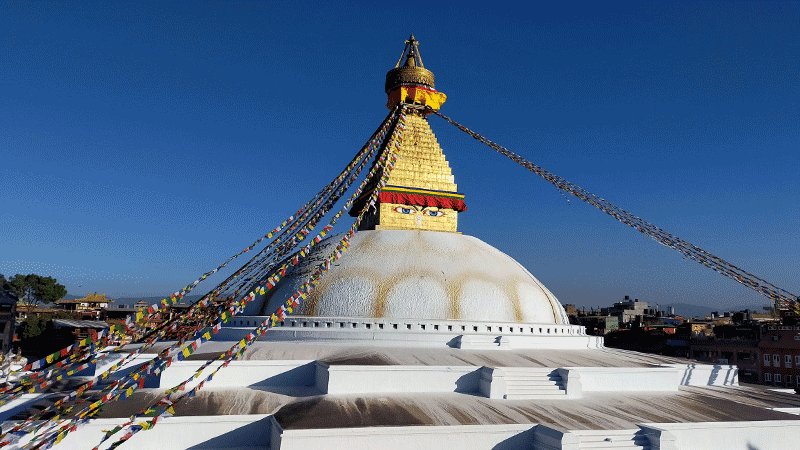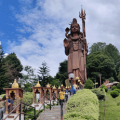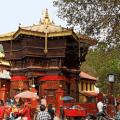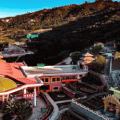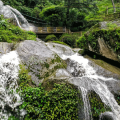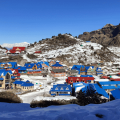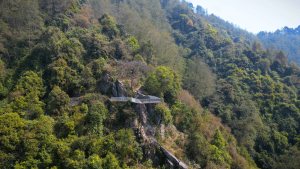Boudha is famous for different names in Nepal, Tibet, and worldwide. This place is commonly known as Boudhanath, Boudha Stupa, Khasti Chaitya, or Khasa Chaitya. Additionally, this stupa is located in Kathmandu, Nepal. It is a significant pilgrimage site for Hindu and Buddhist pilgrims. This stupa is famous not only in Nepal but all over the world. Mostly, Buddhist pilgrims from Tibet visit this holy place and offer prayers. Moreover, it is a UNESCO World Heritage Site. Boudha Stupa is one of the largest stupas in the world. Similarly, this place is also a popular destination for both tourists and locals alike. Almost, there is a crowd around the stupa every day. This is because of the small space around the stupa and the many visitors. Likewise, the stupa is an important cultural and spiritual place for Buddhists.
Boudhanath is often considered the center of Tibetan culture in Kathmandu. The architecture of Boudha and Swayambhunath is somehow similar to see. Every day thousands of visitors walk around the stupa. We can see the pilgrims spinning the holy wheels and chanting mantras. There is a belief that the stupa is from the 14th century. When you visit the place, you feel that Boudha is not just a religious site, but also a cultural hub. This is because the area around the stupa is home to many monasteries and meditation centers. This thing makes it a popular destination for people seeking spiritual retreats and teachings. Additionally, the area around Boudha is famous for its handicrafts. Mostly, there are thangka paintings in shops and galleries around the stupa.
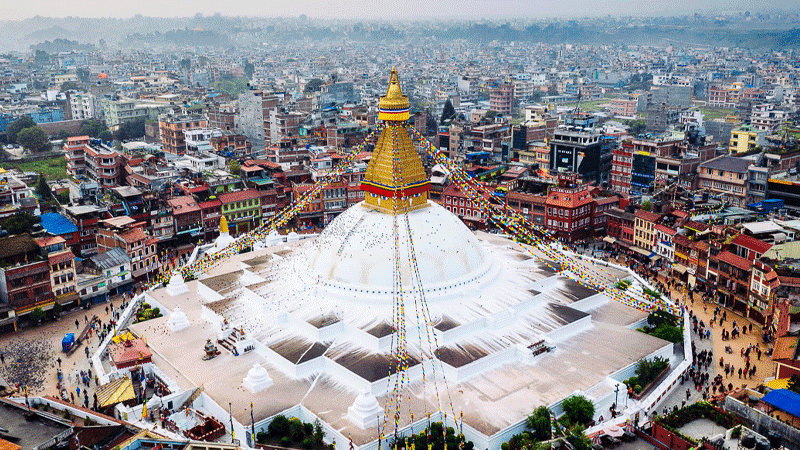
The mythology behind the formation of Boudha Stupa
Newa Buddhist Mythology
According to the history of Nepal, where today Narayanhiti Palace is, was the palace of King Vikramaditya. This was during the Lichhavi period. King Vikramaditya instructed a Dhunge Dhara (a tap of stone) in the southern part of the palace. A new Dhunge Dhara was built at the same place king told but this tap produced no water. The king consulted his astrologers when he did not find water in the tap. Those astrologers suggested a human sacrifice of a male candidate having Battis-Lakshanas (thirty-two perfections). The interesting fact about the candidate was only the king himself and his two princes were suitable candidates. Eventually, the king decided to sacrifice himself to bring water to the stone tap. According to local mythology, the sacrifice was done by one of his sons.
At the time of sacrifice king’s head flew off. Moreover, his head landed at the nearby Sankhu Bajrayogini Temple. The prince went to the top of Bajrayogini and cast off a chicken. At the time, the prince also decided to construct a stupa where it landed. Certainly, the chicken landed exactly where Boudhanath Stupa currently stands. The place was named Khasti because the people at that time were managing to survive the drought by collecting droplets of water. Later, His Majesty’s Government of Nepal renamed the place Boudhanath from Khasti to better reflect the Hinduism of that Hindu nation.
Tibetan Buddhist Mythology
According to the Buddhist tradition, Kassapa Buddha was the Buddha who preceded Sakyamuni Buḍḍha. Sakyamuni Buddha was the twenty-seventh of the twenty-nine named Buddhas After the death of Kassapa Buddha, an old woman, a poultry keeper, Ma-jha-zi-ma with her four sons, interred this great sage’s remains. Moreover, the woman herself built the latter. Before the work of construction started, she requested the King of the time to grant her land the size of a buffalo skin. The king permitted to land and to build the stupa. However, the woman carefully cut the skin into a long strip like a rope and used it to circulate a large area.
The groundwork of the structure was finished through the great sacrifices of the woman and her four sons. The high-grade and wealthy people of the country were ashamed of this work. If such a poor old woman could complete the building, they decided to ask the King to stop the further work. The King replied that he had finished giving the order to the woman to proceed with the work. Moreover, the king said that he could not take back his words. Similarly, the stupa was allowed to be finished. Later, the stupa named as Jya Rung Kha Shor Chorten Chenpo.
History of Boudha
Licchavi records
History says that Boudhanath was founded by the Nepalese Licchavi King Sivadeva. Although, other Nepalese records take it to King Manadeva. Moreover, Tibetan sources claim the bones of King Aṃshuvarma at the stupa. During the Licchavi period, Boudha was an important center for Buddhists. Similarly, many significant religious sites and monuments were built in the country. Boudhanath Stupa was one of them. It was a large, dome-shaped structure. During the Licchavi period also, it was one of the most important Buddhist pilgrimage sites in the world.
Moreover, the Licchavi rulers of Boudha were famous for the arts, and many important works and development in the sector of art and literature took place during this time. However, during the Licchavi period, neighboring kingdoms invaded the region frequently. Despite these challenges, the Licchavi period is a time of great prosperity and cultural development in the history of Boudha. The Licchavi period in the history of Boudha refers to a time when the Licchavi dynasty ruled over the region of Boudha.
Tibetan records
Discussing the Tibetan history of Boudha is close to the history of Buddhism in Tibet. Likewise, Boudha is an important center of Tibetan Buddhism. Similarly, this place has been a destination for Tibetan pilgrims for centuries. King Songtsen Gampo commissioned the construction of several Buddhist temples and monasteries in Tibet and neighboring regions, including Boudha. One of the most significant of these is the Jokhang Temple in Lhasa, which is similar to Boudha in Nepal. Tibetan Buddhism in Boudha continued to grow over the centuries. Likewise, many important Tibetan Buddhist masters traveled to Nepal to teach and spread the Dharma.
In more recent times, Boudha has become an important center of Tibetan exile culture. This is because many Tibetans fled to Nepal after the Chinese occupation of Tibet in 1950. To this day, Boudha is home to many Tibetan refugees and several important Tibetan Buddhist pilgrims. Correspondingly, Boudha remains a significant destination for Tibetan pilgrims and visitors from around the world.
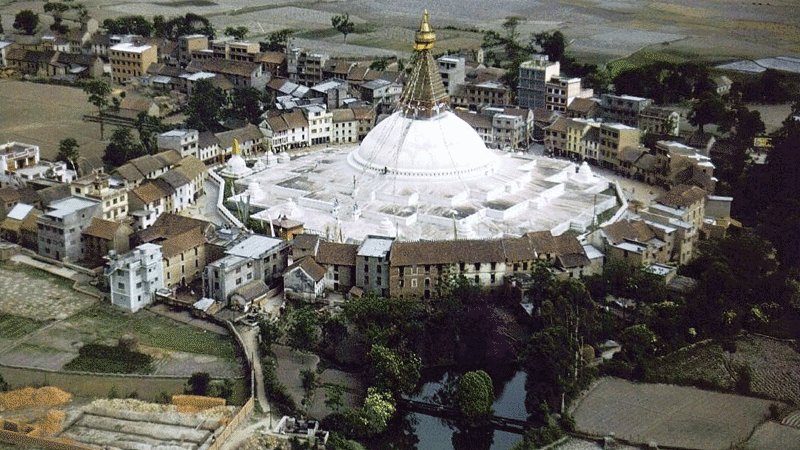
2015 earthquake
The 2015 earthquake badly damaged the Boudanath Stupa. The earthquake destroyed the whole structure above the dome. Similarly, The reconstruction began with the ritual placement of a new central pole or “life tree” for the stupa that lies at the top of the dome. The stupa was again reopened on 22 November 2016 for the public. Boudhanath Area Development Committee (BADC) was responsible for the renovation and reconstruction of Boudha. Private donations from Buddhist groups and volunteers from all over the world funded for the reconstruction of the stupa. According to the BADC, it has a record of 2.1 million dollars and more than 30kg of gold for reconstruction.
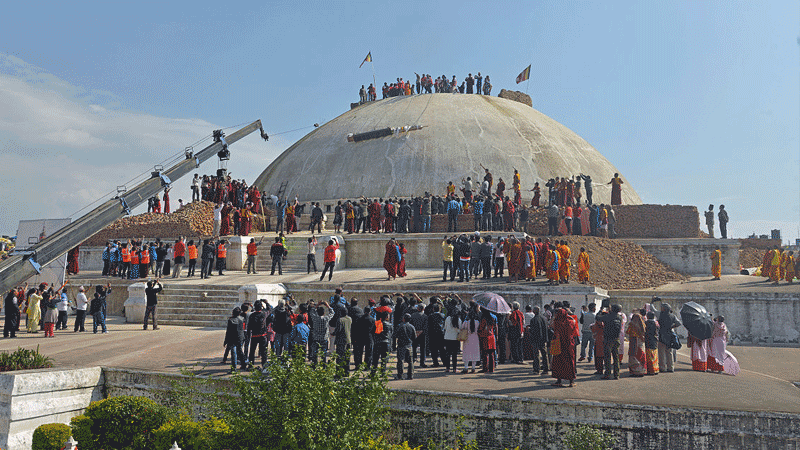
Architecture and Cultural Significance of Boudha
Architecture
The architecture of Boudhanath Stupa is a massive dome structure that stands at a height of 36 meters (118 feet). Likewise, there is a large circular path around the stupa, with prayer wheels and small shrines around. The stupa has carvings and decorations, including images of the Lord Buddha and other Buddhist deities. Similarly, the stupa’s base is made of stone and surrounded by prayer flags. People believe these prayer flags carry prayers and blessings on the wind. There is a golden pinnacle at the top of the stupa. Above the dome-shaped structure, there lie the “All-seeing eyes of the Buddha”. There is a belief that these eyes represent the Buddha’s wisdom and compassion. Around the stupa, several monasteries and shops sell traditional Tibetan and Nepalese crafts and souvenirs.
Certainly, we can see the stupa built on a three-level mandala-style platform. Similarly, there are prayer wheels, prayer flags, and small shrines around the stupa. We can see the huge stupa’s white dome base. Here, the white dome base represents the earth. Similarly, the golden spire represents the air. Likewise, the thirteen rings from the base to the top represent the steps to enlightenment according to the believers.
Cultural Significance
Boudhanath Stupa is one of the important cultural and spiritual landmarks for Tibetan Buddhists. Boudha is one of the holiest places in Nepal for Buddhists and Hindus as well. Certainly, a Tibetian Community surrounds the stupa. The stupa is a pilgrimage site for Buddhists from around the world. Thousands of pilgrims visit the site every year to offer prayers and seek blessings from the stupa. Correspondingly, this is done by walking around the stupa in a clockwise direction, which is believed to bring good luck and purify negative karma.
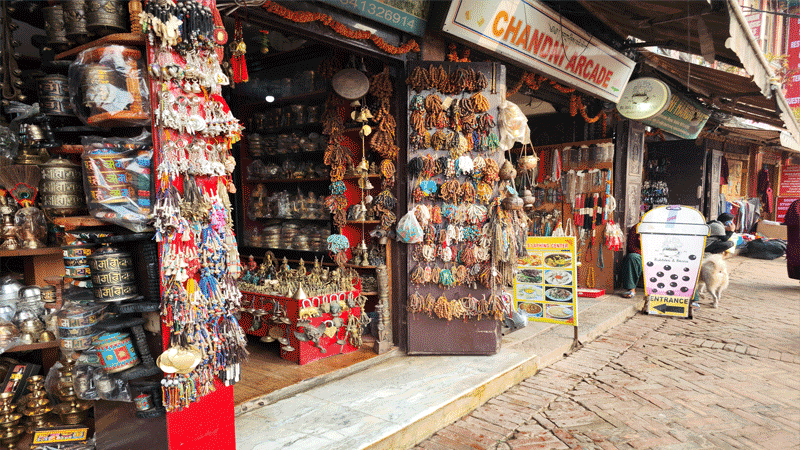
Highlights and Attractions at Boudha
- Boudha Stupa
- Peaceful Environment
- Place having religious value
- Several Monasteries around the stupa
- Shops around selling crafts and souvenirs
- A place to offer prayers and seek blessings
You May Also Like To Read About
FAQs
Boudha is famous for its architecture, and heritage and it has a huge religious significance for Buddhists as well.
Boudha stupa is called “बौद्धनाथ” in Nepali.
A stupa is a hemispherical structure having religious value (typically the remains of Buddhist monks or nuns) and it is a place of meditation.
Besides many myths, Trisong Detsen of the Tibetan Empire is the person for the construction of the Boudha Stupa.
How to reach Boudha
Boudha Stupa is at a distance of 6 km from Ratnapark Bus Park which is near Thamel. It takes about 40 minutes in a vehicle from Ratnapark to reach the destination.
Google Map of Boudha Stupa
Conclusion
Boudhanath Stupa is a unique cultural and spiritual landmark that attracts visitors from all over the world. Its impressive architecture, rich history, and vibrant cultural significance make it a must-see destination for anyone visiting Nepal.

